Washington (AFP) – US President Donald Trump has threatened to broaden his trade war by unveiling reciprocal tariffs Thursday, the latest among sweeping measures targeting allies and competitors alike. Trump’s fresh salvo, which he said would hit “every country,” could bring a broad tariff hike on emerging market economies and add to inflation fears domestically, analysts warn.
– **What are reciprocal tariffs?**
Tariffs are taxes imposed on goods imported from another country. As for reciprocal tariffs — during election campaigning, Trump promised: “An eye for an eye, a tariff for a tariff, same exact amount.” “Every country will be reciprocal,” Trump said Sunday. He was due to hold a news conference offering more details on Thursday afternoon. Analysts expect reciprocal tariffs mean hiking rates on imports to match the level that other countries apply to US products. Matching this based on specific products would likely raise the United States’ average tariff rate by around two percentage points, said Goldman Sachs analysts in a recent note. Doing so to match the average tariff imposed by countries raises the US rate by a smaller amount, the note added. But taking a product-focused approach has its complexities.
While Washington has relatively low average tariffs at a 2.7 percent rate in 2022, it has higher rates in “very politically sensitive” areas such as apparel, sugar, and pick-up trucks, said Cato Institute’s Scott Lincicome. Similarly, including non-tariff barriers like regulations in the calculus would add to complications.
– **Who will be impacted?**
Reciprocal tariffs may open the door to “a broad tariff hike” on emerging market economies that have high duties on US products, JPMorgan analysts expect. If officials go by average tariff rates applied on all products, countries like India or Thailand — which tax imports at higher average rates than the United States does — could be more affected. Trump has previously slammed India as a “very big abuser” on trade, and this week, National Economic Council Director Kevin Hassett told CNBC that India had high tariffs that lock out imports.
Lincicome cautioned that high tariffs are often also imposed by poorer countries, who use them as a tool for revenue and protection, as they have fewer resources to impose non-tariff barriers like regulatory protectionism. Goldman Sachs estimates that “there should be no effect on countries with free trade agreements like Mexico, Canada, and (South) Korea, limiting the overall impact” if Washington took a country-based approach to reciprocal tariffs.
– **What are the complications?**
It remains unclear if Trump views reciprocal tariffs as an alternative to a universal tariff of between 10 and 20 percent that he floated on the campaign trail — or a separate policy. One risk is that the Trump administration could use “reciprocal tariffs” to address non-tariff issues, said Goldman Sachs in a note. In particular, he could consider value-added taxes (VATs) when deciding how much to adjust tariffs. Doing so stands to raise the average effective tariff rate by another 10 percentage points, Goldman analysts added. Such a move might also be a response to high European Union VATs, JPMorgan said.
– **What is the goal?**
“One of the objectives is to create uncertainty as a negotiating tactic, but uncertainty is a tax on doing business,” Jeffrey Schott, senior fellow at the Peterson Institute for International Economics, earlier told AFP. Unpredictability surrounding tariffs, retaliation, and non-trade issues all contribute to a situation that weighs on US and foreign firms, he said. In the case of allies like Europe, Schott said, US objectives in negotiation could involve “economic and geopolitical priorities, including Ukraine.” They could include finding a better resolution of the situation in Ukraine, which has been fighting off a Russian invasion since 2022, but also to expand US exports in key sectors like liquefied natural gas (LNG).
– **Two-way street?**
When it comes to its average general tariff rate, the United States stands around the middle among wealthy, industrialized countries, said Cato’s Lincicome. “Should Trump’s system be based on average tariff rates, then ‘true’ reciprocity would require US tariff rate reductions on goods from dozens of countries,” he added in a recent report.
© 2024 AFP




















